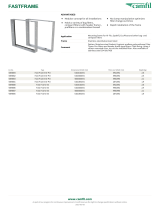
G85139-H1750-U049-B
Siemens plc 199
26/09/97
Safety Instructions
Before installing and putting this equipment into operation, please read these safety instructions and
warnings carefully and all the warning labels attached to the equipment. Make sure that the warning
labels are kept in a legible condition and replace missing or damaged labels.
WARNING
This equipment contains dangerous voltages and
controls dangerous rotating mechanical parts.
Loss of life, severe personal injury or property
damage can result if the instructions contained in
this manual are not followed.
Only suitable qualified personnel should work on
this equipment, and only after becoming familiar
with all safety notices, installation, operation and
maintenance procedures contained in this manual.
The successful and safe operation of this
equipment is dependent upon its proper handling,
installation, operation and maintenance.
•
MICROMASTERS operate at high voltages.
•
Only permanently-wired input power
connections are allowed. This equipment must
be grounded (IEC 536 Class 1, NEC and other
applicable standards).
•
If a Residual Current-operated protective
Device (RCD) is to be used, it must be an
RCD type B.
•
Machines with a three phase power supply,
fitted with EMC filters, must not be connected
to a supply via an ELCB (Earth Leakage
Circuit-Breaker - see DIN VDE 0160, section
6.5).
•
The following terminals can carry dangerous
voltages even if the inverter is inoperative:
- the power supply terminals L/L1, N/L2, L3.
- the motor terminals U, V, W.
•
Only qualified personnel may connect, start
the system up and repair faults. These
personnel must be thoroughly acquainted with
all the warnings and operating procedures
contained in this manual.
•
Certain parameter settings may cause the
inverter to restart automatically after an input
power failure.
•
This equipment must not be used as an
‘emergency stop’ mechanism
(see EN 60204,
9.2.5.4)
• If motor thermal protection is required, then an
external PTC must be used. (
Refer to Sectio
2.3.5.)
• Lowering the fan tray on Frame Size C
MICROMASTER exposes rotating parts
.
Power must be isolated prior to this operation.
CAUTION
• Children and the general public must be
prevented from accessing or approaching the
equipment!
•
This equipment may only be used for the
purpose specified by the manufacturer.
Unauthorised modifications and the use of
spare parts and accessories that are not sold
or recommended by the manufacturer of the
equipment can cause fires, electric shocks and
injuries.
•
Keep these operating instructions within easy
reach and give them to all users!
European Low Voltage Directive
The MICROMASTER product range complies with the requirements of
the Low Voltage Directive 73/23/EEC as amended by Directive
98/68/EEC. The units are certified for compliance with the following
standards:
EN 60146-1-1 Semiconductor converters - General requirements
and line commutated converters
EN 60204-1 Safety of machinery - Electrical equipment of
machines
European Machinery Directive
The MICROMASTER inverter series does not fall under the scope of
the Machinery Directive. However, the products have been fully
evaluated for compliance with the essential Health & Safety
requirements of the directive when used in a typical machine
application. A Declaration of Incorporation is available on request.
European EMC Directive
When installed according to the recommendations described in this
manual, the MICROMASTER fulfills all requirements of the EMC
Directive as defined by the EMC Product Standard for Power Drive
Systems EN61800-3.
UL and CUL listed.
ISO 9001
Siemens plc operates a quality management system which complies
with the requirements of ISO 9001.






















